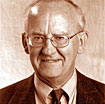Commentary on Jeremiah 28:5-9
My work on this text was interrupted by a telephone call from a Jewish friend. When I told him I was dealing with the encounter between Jeremiah and Hananiah, he immediately launched into a narrative telling of his role in a play produced at a summer Hebrew camp.
He had taken the part of the false prophet Hananiah and reported with glee how these high school students had constructed a breakaway yoke for Jeremiah’s neck and how he, at center stage, had taken the yoke from Jeremiah’s neck and smashed it over his knee. The play climaxed with the burning of a model of Jerusalem on the beach of a Wisconsin lake.
Historical and Literary Observations on the Text
The opening of the Jeremiah book indicates that the materials in the book are associated with the prophet’s work in Jerusalem from the time of Kings Josiah (640-609 BCE) through the administrations of his sons Jehoiakim (609-598) and Zedekiah (597-587). Josiah was a good and godly king who achieved religious reform and a measure of political independence for Judah. After he was tragically killed at the pass at Megiddo in 609, Judah’s downhill slide into Babylonian domination and finally exile (597, 587) began.
Jeremiah tried to call his nation back to faithful covenant living (Jeremiah 7, 26) but was opposed and persecuted. Banned from speaking in public, the prophet had dictated his message to his secretary Baruch, who passed it on to Jehudi, one of the king’s people. While Jehudi read Jeremiah’s words from the scroll, the king sliced them off, a few lines at a time, and arrogantly tossed them into the fire (Jeremiah 36). Another incident: At one point Jeremiah delivered a scathing woe-speech to Jehoiakim, contrasting his oppressive and evil policies with those of his father Josiah and announcing that the king would be buried with all the honor of the jackass he was! (Jer 22:13-19). Clearly the prophet and the day’s leading politicians did not get along!
Today’s text is a part of a narrative in chapters 27 and 28, set in the fourth year of Judah’s last king, King Zedekiah, that is, 594/3 BCE. Fulfilling a command of the LORD, Jeremiah goes about wearing a wooden ox yoke to dramatize his message: submit to the yoke of Babylon! Jeremiah appeared before an international conference in Jerusalem, which included representatives from Edom, Moab, Ammon, Tyre and Sidon. Apparently they were trying to decide what to do about the Babylonian problem (27:1-3). The prophet’s message (from the LORD!) to them was clear: Don’t rebel! (27:5-11). He delivered the same message to King Zedekiah (27:12-15) and to the priests and his own people (27:16-22).
Chapter 28 introduces the prophet Hananiah who delivers a private message to Jeremiah. He claims the message is from the same LORD Jeremiah represents and promises that the king and the exiles will be back home in two years (28:1-4).
Reading Jeremiah 28:5-9
What was Jeremiah’s reaction to this “good news” brought by Hananiah? At first he says, “May it be so! I too hope the sacred vessels the Babylonians have stolen will be returned, and the exiles will come home.” But then the prophet’s tune changes into a different, typically jeremian key! He addresses Hananiah as a colleague, speaking of “the prophets who preceded you and me…” Then he observes that those real prophets typically prophesied doom–war, famine, destruction–seeking to bring about repentance and finally deliverance. As for Hananiah’s prophecy of shalom (peace)? Jeremiah says: “I’ll believe it when I see it!”
Then comes one of the most dramatic scenes in the literature of the Hebrew prophets, worthy of dramatization by high school boys at a summer camp. Hananiah steps up to the respected prophet from Anathoth, tears the wooden yoke from his neck and smashes it in front of the crowd that had gathered. Then, using the same messenger-formula that the authentic biblical prophets used, he delivers his own message: “Thus says the LORD: I’ll smash the Babylonians and bring all the exiles back within two years!” And Jeremiah? He walked away from that fight.
Toward Preaching on the Text: “True or False?”
It’s a dramatic story and preaching on this text will want to re-tell that story in a dramatic way. The preacher may wish to say something about the false prophets that populate the Bible from the time of the contest between the prophets of Baal and Elijah on Mount Carmel (1 Kings 18:20-40) to the days of Micah, when priests and prophets tailored their teaching and preaching to the size of the salaries (Micah 3:11), to the time of Jeremiah himself (note Jer 23:9-40).
The false prophets of Jeremiah’s day prophesied by other gods such as Baal, the god of sex and success (Jer 23:13). These prophets keep saying “Don’t worry! Everything’s going to be fine (Jer 23:17)! But they have drummed up their own “prosperity preaching” and none of them has ever been in on the LORD’s own council (Jer 23:18, 21-22). Their words are smooth, sweet, comforting. “But my word,” says the prophet speaking in the name of the LORD,” is like fire, like a hammer that breaks a rock in pieces!” (Jer 23:29)
Are there false prophets around today? The preacher will have to reflect on that question, in his or her own context and in the light of the words of Jeremiah. For starters, I quote from this week’s Star Tribune which begins an article with the statement: “Is the ‘Prosperity Gospel’ facing a recession?” Following is a report of seminars held by a number of “Prosperity Gospel” churches and how they are dealing with complaints about “the lavish lifestyles of their ministers.”1 And I point out that the Christian Century which arrived yesterday (Feb. 26, 2008) features a consideration of “today’s soft-core atheists.” What would Jeremiah say about these professors and “preachers”? Somewhere in all this, there’s a sermon.
1Star Tribune, Feb. 18, 2008, B1-2.

June 29, 2008